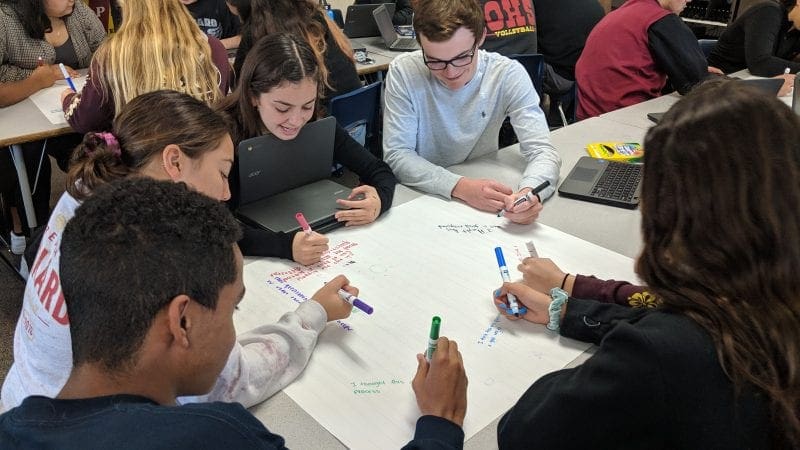Every fall, teachers look for new ways to kick off the year on a high note.
There’s a lot packed into the first few days of a new school year. You need to set norms and expectations, share the syllabus, preview content, and learn everyone’s name and learning style.
You also want to build positivity, energy, and relationships among a brand new group of kids. It’s a high bar, and the Question Formulation Technique (QFT) can help.
Many teachers use the QFT in the first few days of school. They find it sets the tone for curiosity and collaboration for the rest of the year.
Six reasons the QFT can be a great way to start the year
- You immediately establish a classroom culture that is collaborative and values every voice.
- You send a message that questions are valued and expected.
- You engage students with challenging, authentic thinking right away — through a process that gives them lots of independence. You’re setting the expectation that students will work hard and take ownership over their learning.
- You invite student input and buy-in for setting expectations and norms for the rest of the year.
- You renew your commitment to curiosity and inquiry as a central component of your teaching and planning.
- You learn about your new students and get to observe what and how they think. You get immediate insight into who they are and what makes them tick.
How to incorporate the QFT into the first few days of class
Here are four ways to work the QFT into your first few days of school.
1) Use the QFT to engage students in setting classroom norms and expectations.
Twitter users Alyssa Park and Wanda Faye Bryant have had success with the following Question Focus: “We need rules in the classroom.”
For example, Park’s fourth-grade class formulated some interesting questions:
- “What if we didn’t have rules?”
- “Are rules safe?”
The final lists of questions from the #qft we did today. We will use in our next steps of creating the expectations we have for our 4th grade classroom. @RightQuestion thank you for amplifying my request for help developing a plan a few weeks ago! #dcsdlrnr #sesrocks pic.twitter.com/8pGLM7nQ1Q
— Alyssa Park (@MissParkSES) August 15, 2018
Later, her students used their questions as a jumping off point to help create their own classroom rules.
Using yesterday's #qft priority questions (Who makes the rules? Why do we have rules?) to guide today's work in creating classroom rules. Students generated rules they thought we should all agree to follow, and gave a justification for each rule. #dcsdlrnr #sesrocks pic.twitter.com/JiiVcJC9lv
— Alyssa Park (@MissParkSES) August 16, 2018
2) Use the QFT to preview central themes and key content that students will learn during the upcoming year.
This engages students in setting a yearlong learning agenda or overarching essential question. Here are some examples.
- Calculus: By showing students a set of graphs, Christine Relleva, an AP and honors calculus teacher in Massachusetts, engaged students immediately with sophisticated mathematical reasoning that they would be practicing all year.
- History: A Rhode Island history teacher used this quotation, by Maya Angelou, to help students design driving questions to guide their yearlong study of U.S. History: “History, despite its wrenching pain, cannot be unlived, but if faced with courage, need not be lived again.”
- American literature: In Oxnard, California, Jennifer Brickey, Kimberly Tahsuda, and Jay Sorensen used a fascinating visual representation of “The American Dream” as a QFocus. Here are the results. Imagine starting a year of American Literature with student-produced questions like, “Is the American Dream a little less true for some people?”
3) Use the QFT to learn about your new students and gauge their interests and expectations.
A teacher in Hyde Park, New York, presented students with a picture depicting the exterior of their school along with the statement, “As a member of [School Name’s sixth-grade class], you will have numerous opportunities to grow and learn.”
Students were able to name many anxieties and curiosities about entering middle school, such as, “What is the point of lockers?” and, “Who is the boss of the superintendents?”
On Twitter, Rebecca Kinnee shared a similar Question Focus: “My sophomore English class.” After formulating questions, students used the syllabus to answer them — a “critical thinking and reading activity,” Kinnee notes. Imagine never having to read your syllabus aloud again!
Starting off the year with a qft. I HATE reading the syllabus to students, so I turned it into a critical thinking and reading activity. LOVED the results! Students as creators, not consumers @Wheeling_Cats @mskateglass @gabriella_stetz #214ready pic.twitter.com/VXzhgYG0GG
— Rebecca Kinnee (@rkinnee) August 16, 2018
4) Use the QFT to help students set goals for themselves and their learning.
Also on Twitter, Ms. Schaffer worked with students to contemplate what it means to succeed. She used the Question Focus, “Every student in this space will find success this year.” By giving students this early chance to name their goals and strategize about how they might achieve them, Ms. Schaffer set up every single student to succeed in her class.
Today, we used QFT (Question Formulation Technique) to unpack what it means to find success – from these amazing questions, we were able to form a working definition of success, but also brainstorm strategies and means of getting there. #SchafferScholars #DalerPride pic.twitter.com/xBLQyvBnEQ
— Ms. Schaffer (@ms_schaffer1) September 7, 2018
We want to hear from you! If you have examples of how to use the QFT at the beginning of the school year, send us a tweet to @RightQuestion, and use #QFT.
